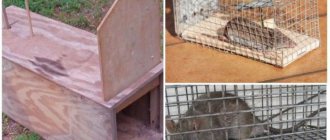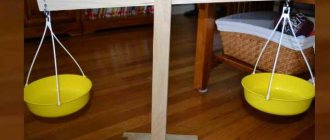Rats are vermin that have no place around people. They cause serious harm, spoil things, destroy food supplies, damage clothing, various household items, furniture and much more.
The fight against them can be complicated by the fact that these animals reproduce quickly, so be prepared that in just a few months you will no longer have 1-2 rats, but a dozen. Rat traps have been used to destroy them since ancient times.
Many stores offer ready-made options, but you can make rat traps with your own hands. Moreover, there are different types of devices that can be made from inexpensive materials at hand.
Why do rats start
The relationship between rodents and humans has never worked out; pests spoil food, gnaw clothes and walls in the house, and most importantly, like many centuries ago, they become carriers of diseases. The conditions for the appearance of rats and mice in the home can be the following factors:
- sufficient food;
- normal room temperature (heated object);
- location of a landfill or trash can nearby;
- lower floors of high-rise buildings - uninvited guests come from basements;
- unsanitary conditions in a certain apartment can become a nursery, a place where tailed animals spread throughout the house;
- the presence in country houses and sheds where domestic animals live - rats find a constant source of food and steal food from pets.
Ingenuity is man's main trump card in destroying parasites that spoil property and spread life-threatening diseases.
It is not always possible to immediately understand that “gray” robbers have settled in a home. Rats are cautious creatures, of course, if their colony increases, then they will be noticeable visually. You need to pay attention to the following aspects:
- specific smell in small rooms;
- fussing under the floor, behind the walls or squeaking;
- rodent droppings in different rooms and under furniture;
- spoiled food;
- holes and gnawed walls, wooden products;
- "sewn" paper.
Making a trap yourself is quite simple, the main thing is to follow the instructions and “don’t reinvent the wheel.”
Important to remember. Rats are carriers of the following diseases: tetanus, leptospirosis, typhus, etc. They are dangerous for both country houses and city apartments. Catching pests is the key to the health of your family!
Precautions
Rats
Now you need to consider ways to protect yourself.
In fact, there are quite a lot of options, you can adapt each method to your situation, it depends on the conditions.
Natural enemies. We must not forget about cats, mouse and rat hunters. Many people get cats for this very purpose. You should remember that. That wilder cats are better at hunting. You should not take purebred pets for this not so simple mission. You also need to remember. That some cats are good at catching mice. But they can't handle rats. These breeds include the Sphynx
An important condition is to vaccinate your pet against diseases transmitted by rodents in order to protect it. Repellent
Not always effective, but deterrents such as smell or sound can still be used
Rats have very sensitive receptors, especially for odors.
Therefore, you can use substances such as ammonia, vinegar, kerosene or acetone. If you take sound into account, the most effective method is ultrasound. A person is unlikely to hear anything since he simply does not perceive these frequencies, and the rats do leave, but not for long
Poison. Not an effective method, but you can try. Rats are considered quite cunning rodents; their vitality often amazes even scientists. One of the main disadvantages of this method is that after death the rodent leaves behind a persistent smell of decomposition. Traps. Quite a radical method, but it is really effective. After using traps, a person will immediately understand that the rat no longer poses a danger. It cannot be ruled out that over time animals learn to bypass traps that have a guillotine mechanism.
To summarize, we can say that rats and mice cause great harm to people, so it is important to take care of your safety measures and protect yourself from meeting them. To do this, you need to make traps for them or order them online if there is no other option. https://www.youtube.com/embed/m0lmXTIznuU
How to make a rat trap with your own hands
DIY rat traps are by far the most effective way to catch those pesky rodents. The main thing you need to pay attention to is that the trap should be quite durable and of medium size. You need to take into account the fact that tailed animals can even chew through some types of concrete. In addition, an animal “backed into a corner” becomes as aggressive as possible. A small creature is able to withstand a huge (for these individuals) person. This means that the rat trap must be reliable, and the hostile creature must not, under any circumstances, injure a person.
The main advantage of a homemade trap is that you yourself know how it works, how it works, and you can also make a number of changes and modifications yourself.
A homemade device is sometimes more effective against rodents than purchased models. You can put your creative ideas into the mechanism; in addition, rats are curious and are attracted to incomprehensible designs.
In order to make a trap with your own hands, you do not need to create “high-tech” units; clear and simple designs that do not require specific materials are the most effective. And if a novice engineer-master shows a little ingenuity, you can create a formidable “machine for destruction.”
Most often, these are rather simple designs for catching rats, which can be made by spending a minimum of time and materials on manufacturing.
Note. If you hope that when several individuals appear, you should not take radical measures, you are deeply mistaken. One pest is capable of breeding about twenty cubs per month. Therefore, only total destruction is the right way out of the situation.
Tipping
This method is catching “tailed robbers,” which means that the animal will approach the bait and fall into a deep space.
Alternatively, you can make a rat trap with your own hands based on a tilting bar.
- One of the popular options for creating a “tunnel”:
- we make an imitation of a tunnel from a plastic pipe or cardboard;
- we attach the tunnel structure to the edge of the table (tape, glue, etc.), the upper part of the device should hang over the “abyss”, and the bottom should be cut off;
- at the very edge, inside the pipe there should be a “treat”;
- where the table ends, you need to place a deep container of water;
- the rat runs along the passage towards the bait and falls down.
- You can also catch annoying animals using another overturning method: place a falling bridge with bait on the edge of the barrel, and bring a ladder (board) to it.
Thus, the rat, tempted by the treat, will end up in the bucket from whichever direction it enters.
Additional Information. Any container: bucket, barrel, can - must be filled with water, so the rodent will not be able to get out.
From plastic bottles
In order to make a trap from a plastic bottle, you don’t need many different materials - one of the simplest methods used in practice. There are a huge number of types of these devices, but their main principle of operation lies in the functional use of the bottle.
This is probably the simplest and cheapest option for a DIY rat trap, and does not require much ingenuity.
Let's look at the most effective traps:
- “Closing trap” - classic type:
- plastic containers are cut (a stylized door is created);
- the cut part is pierced with a straight pin or a wooden stick - this is the fastening for the harness (rubber spring);
- a similar pin pierces the inside of the container - also a kind of fastening;
- two rods are connected with an elastic band or a tourniquet;
- the release mechanism is attached to the bottom, the bait is hung on it, the pest pulls the bait, the mechanism is triggered, the rat is caught!
- “Spinning trap” - made from an ordinary plastic bottle:
- the container is “fitted” onto a knitting needle or pin (the main thing is that the device rotates freely);
- the finished mechanism is lubricated with sour cream;
- the entire apparatus is attached to a barrel (large bucket);
- a ladder (board) is needed to reach the barrel;
- the animal jumps on the bottle, it turns and the voracious creature flies into the abyss.
An animal sneaking behind the bait will turn the bottle over and fall into the bucket.
Covering live trap
This method of controlling rodents has been known since time immemorial.
- The simplest device is a jar (pan) and a coin. Food is scattered near the trap, the jar is placed on the “money”, the rat will certainly touch the coin when it runs near the trap. The main thing is that at the moment when the stylized trigger is touched, the animal is inside the device.
- More modern option:
- we find a suitable container (bucket, pan, etc.);
- We install a rod inside the container and tie a thread with bait onto it;
- the thread should also be attached to the coin (sometimes a cardboard corner is used, and the bait is placed on it;
- the mammal pulls the thread, the stand falls, the “glutton” is caught!
You can make such a rat trap with just a jar, bait and a coin.
Cage traps
Homemade products of this type have proven themselves very well in pest control. For some people, this design may be a heavy option, requiring iron materials and a drawing of the mechanism. Of course, if you want, you can master this method too - this is not a “high-precision converter project”, but an iron rat trap.
- a sufficiently strong steel cage is required;
- on the one hand, a door is attached to the cage, which is lowered using a spring;
- at the end of the fence food is attached to the trigger mechanism;
- The tailed one grabs the treat, the device works, the doors close!
Not the most common, but one of the most effective options for catching small pests.
Tunnel trap
This design is very often used to exterminate not only rats, but also mice and moles in summer cottages; it is not like a tunnel-type rat trap that tips over; it operates on a completely different principle:
- you need a piece of pipe (plastic) or other product sealed at one end;
- needles are attached to the end and are directed inward;
- the bait is placed inside the trap;
- the individual enters inside unhindered, cannot get out, the needles kill the animal, or it will remain inside the trap.
An interesting type of homemade rat trap.
Cylinder traps work on the same principle, but without needles. The animal climbed inside and couldn’t get out because of the smooth walls.
Silky
To be honest, this method of catching rodents is quite troublesome. The reason is the small size of the animal. But, if you get used to it, you can successfully complete your hunt. Here's everything you need to make such a trap yourself:
- nylon cord;
- a piece of fishing line;
- insulating tape;
- sinker;
- stationery rivets;
- nuts, bread for bait.
An ancient method that was invented a long time ago by hunters who hunted small forest animals.
For this unit to work successfully, you need to clearly select the load in mass equivalent. If it is too light, the tourniquet simply will not tighten with the required jerk. And the object of the hunt will run away.
Let's get started:
- you need to make a loop from the cord;
- the imitation noose must be attached to any wooden surface;
- the bait must be attached to the same surface, the path of the animal must clearly pass through the noose (you must also take into account that the rat must remain in the middle of the loop while capturing the bait);
- we attach a fishing line to the “treat”, stretch one end to the noose;
- We hang a sinker in the center on the fishing line;
- the annoying rodent grabs the bait, the sinker pulls down, the noose tightens.
Place the loop and bait so that when the rat reaches for the food, the loop is in the middle of the pest's body.
Note. This technique is universal and suitable for individuals of different ages.
Zürner trap
This technique is very similar to classic overturning traps, but with its own characteristics.
- visually the trap resembles a wooden toy house;
- there are two entrances;
- a narrow corridor where there is a bait station at the central point of the canopy;
- the floor is hinged on both sides;
- a small creature wants to feast on a delicacy, but instead falls into the “basement” of the house, and the floor boards return to their original position.
The classic trap, the principle of which is used in many similar traps, is not necessarily for rats.
It is unlikely to purchase a unit in a store; all elements must be made independently. Due to the troublesome nature of the project itself, such a trap is rarely used in practice.
Additional Information. This device gives you a chance to catch several rats.
Glue traps
There are many rat traps of this type on sale, but it is not always possible to purchase the device. For example, in the countryside or in small shops these products are often not available. It’s easy to make such a trap yourself. You need to buy specialized glue that attracts animals with its smell. We take a sheet of cardboard and spread it with glue, and put complementary foods in the middle. A floundering creature, attracted by a peculiar aroma, will completely stick to the surface.
In household or hardware stores, you can often see glue with images of rats or mice on the shelves. This is a special glue for catching rodents.
Important! There are significant disadvantages of such devices: the animal, as a rule, does not die immediately, but gets nervous and screams, which is very unpleasant for susceptible individuals. A cat or dog can also get caught in a trap, and then it takes a very long time to get them out of the uncomfortable situation.
Electric rat trap
Models of electrical devices are quite popular today. They are not as difficult to make as they seem:
- you need plywood on which holes are made for the wires;
- We cut out several rectangles from aluminum cans and make holes in them;
- we stretch the wires through the slots (we make different polarities in the wiring);
- you need to output two common wires to the structure (plus and minus);
- we attach rectangles on plywood (with glue), in one row, at a short distance (we connect a phase to one plate, and a zero to the second);
- you will need an electronic unit, which can be borrowed from an insect racket; we place it on plywood, short-circuit the electrodes in order to remove the existing charge;
- add a capacitor;
- cut off the bottom of the plastic bottle, install it in the form of a house on top of the aluminum rectangles;
- food is poured inside the house;
- we plug the trap into the network, the animal receives an electric shock when it touches both plates.
A relatively humane method for those who do not want to look for options on how to kill a caught rodent.
Wire noose
The trap of such a device can exactly replicate the structure of a snare. Just use steel wire instead of a cord. You can also make an imitation of a hunting snare, attach a steel noose to the surface near the bait, so that the animal that reaches for the bait has a deadly noose on its body.
An interesting option for catching parasites, often used when hunting small animals living in burrows.
In order to fix the animal in the hole, a wooden beam is made with several “holes” and spring mechanisms.
Plastic trap pit
To set up such a trap, it is enough to have a container (from five liters), you can use a bottle:
- on the open space, place a Whatman paper cut in the middle using a ribbon method or a regular sheet of paper (with a cross-shaped size);
- the paper is secured with tape;
- bait is suspended above the container;
- a bridge is made from a board to the top;
- the animal jumps on the paper, trying to reach the treat and falls into the “abyss”!
The rodent will reach for food and fall down into the trap.
Tin Can Trap
Very similar to the Spinning Bottle design, only here we use a beer can. The mechanism turns and the rodent is in the bucket!
Versha
To catch rats, they use tops, similar to fishing gear. A cage with a cone entrance: the animal runs inside, but cannot go back out - the second entrance is a dead end. You can't go back either, the door only locks in one direction. The general meaning is that there is an entrance, but no exit!
The rat will climb inside the trap, and the mesh behind it will return to its previous position, preventing the rat from getting back in.
How to catch a rat at home? Today there are plenty of options: you can get a cat, use chemistry, but it’s better to make a rat trap with your own hands!
Bucket and tin barrel trap
There are several options for rat traps for rodent control, which can be made from a bucket and a tin barrel. They do not require much time or large expenses.
For example, you can build the following device from a bucket:
- You need to pour a solution of salt into the bucket;
- You need to pour a layer of sawdust on top. Due to the fact that there is salt water in the container, the sawdust will not drown;
- A fragrant bait is placed on top of a layer of sawdust;
- Place a board next to the container so that the rat can get to the bait;
- As soon as the rodent gets to the treat, it will fall through the sawdust and drown.
You can make the following device from a tin barrel:
- A tin barrel is placed next to the table;
- A board is placed on the edge of the table. One edge of this element should protrude above the container;
- It is worth placing a fragrant treat for the rodent on the edge;
- The animal, sensing the smell of the bait, will approach it, and as soon as it steps on the edge of the board, it will fall straight into the barrel.
How to install correctly
Most successful rat catchers say that traps should be placed in the habitats of the animals. You can not immediately set a trap, but lull the wary animal’s vigilance by placing bait on an unspecified trap. A constant diet will make the rat less cautious and the success of the enterprise is guaranteed.
Traps should be installed in places where pests appear; they can be identified by a large accumulation of excrement.
After use, the trap must be cleared of the smell of the deceased creature, so as not to scare away new “candidates for capture.” The trap must be installed against the movement of the “tail”.
Additional Information. The rodent does not like illuminated areas and moves near walls and not in open areas - this must be taken into account when installing trapping devices.
The advantage of handmade
The main advantage of a homemade trap is that you yourself know how it works, how it works, and you yourself can make a number of changes and modifications aimed at improving the performance of the trap for rodents. Most often, these are rather simple designs for catching rats, which can be made by spending a minimum of time and materials on manufacturing. The appearance of these parasites, unfortunately, is not uncommon in apartment buildings with a garbage chute. I myself often encountered a tailed beast jumping up the steps of a flight of stairs. It is best to deal with this type of problem yourself to be sure of the result.
The best bait for a rat trap
The diet of rats is varied; traps can be loaded with the following baits:
- cheese;
- grain crops;
- bakery;
- cottage cheese;
- sausage;
- smoked meats;
- sour cream;
- nuts;
- sunflower oil and seeds;
- salo;
- even beer, etc.
Animals love fresh and smoked food most of all; rodents should not be underestimated, they are quite selective.
"Versha"
A similar trap, installed to catch rodents, is very popular among hobbyists. In the drawings it looks like a small cell with a cone-shaped entrance. Another entrance is installed in the trimmed base of the cone-shaped structure. As a result, the rodent ends up in a dead end, the base of which is a bottom made of a metal plate. It is secured with a wide base, but it can easily rotate on a hinge.
The plate is attached to the cone below, a counterweight is obtained, and a possible exit for the animal is hidden. It is imperative to place one or another bait in the trap; the rat will definitely smell it from afar and become interested. As a result, she will try to go inside the structure made for her. Getting to the bait will be easy. The rat will see that he can get out. The rodent will then fall into another cone. The structure will lower under the weight of the animal, and the rodent will fall to the bottom of the trap.
The main feature of the “top” is the ability to catch not just one rat, but several. To remove them from the trap, you only need to open the door.
The best commercial rat traps
The following commercial traps can be distinguished:
- Press traps.
- Tunnel traps.
- Electrical devices.
- Mesh traps.
- Ultrasonic repellers, etc.
For many, ultrasonic repellers have already become an excellent alternative to other control methods that involve killing animals.
Fishing principles
Rats get used to one familiar bait. This means that it should not be kept in a rat trap for more than 3 days in a row.
It is better to replace it with a new bait more often in order to lure it out and not cause alertness or suspicion in the rat. Despite the fact that the animals are omnivores, they still like to give preference to their favorite foods, rushing into the trap. If mechanical traps are used, it is important to place them near the walls and block access to them for children and pets. It is worth keeping rat traps clean at all times. Handle them only with gloves. Regularly remove food products from the kitchen, leaving no food sources other than a mousetrap. Store cereals in glass or metal jars.
What to do with a rat trap and a caught rat
Of course, a person is no longer a medieval barbarian, but in relation to a caught rat, there is only one solution - liquidation. This can be done as follows:
- add water to the container so that the animal drowns;
- a precise blow to the head with something like a bat;
- shoot the pest if you have a suitable weapon;
- if it is possible to transfer the animal into a sealed container, you can send the “criminal” to the gas chamber. Mix soda and vinegar in a cup, pour into a container, the animal will suffocate (this is considered a humane method of punishment).
The methods described seem terrible, but a person cannot, like the Pied Piper of Hamelin, control animals with a pipe, so there are simple methods of elimination.
Still, the best way would be to choose a trap that does not cause any injury to the animal and subsequently release it away from the area.
Option number 3: covering live trap
This is perhaps the simplest version of a homemade rat trap. To catch a rat or mouse with it, just take a pan and a coin of suitable size - turn the pan upside down, tilt it slightly and rest one edge of it against a coin placed on its edge.
Bait is placed under the pan. When the rodent climbs for the bait, it will certainly touch the coin, it will tip over and the pan will cover the animal.
Here is an example of an implementation where a jar is used instead of a pan:
The disadvantage of the design is frequent false alarms (when a rat touches a container or coin before it has climbed inside the rat trap).
A more sophisticated homemade trap of this type is the improved “coin container.” For example, a container can be rested on an unstable stand, a thread can be tied to the stand, the thread can be thrown over a spacer in the container and the bait can be tied to it:
The rat will sneak under the container, pull the bait and move the “guard”.
Another option is to use a strip of cardboard of sufficient height instead of a coin with a special corner for attaching bait:
Here the animal, pulling the bait, knocks over the cardboard and covers itself with the trap.
It is only important to keep in mind that to make homemade rat traps you need to take a container that is heavy enough so that the rat cannot move it.
The video below shows another interesting example of such a rat trap:
Preventing the appearance of rats in the house
For preventive actions to prevent the appearance of rodents in your home, you need to follow the following recommendations:
- seal openings and cracks in the house;
- get a cat;
- throw away garbage on time;
- tidy up the apartment;
- Do not flush food waste down the toilet;
- find a separate place for products and cereals, where there is no access for pests.
Cats are an effective rat repellent.
Rodents really don't like the smell of cats. Homemade products for fighting rats have proven themselves to be excellent. They are effective even in comparison with some factory products. If “uninvited guests” appear in the house, there is a way out - the complete extermination of the entire colony using simple, homemade devices!
Bird snare
You can fight birds using a hunting snare. With its help, it will be possible to detain even individuals of impressive size.
Assemble the structure according to the diagram posted on the website. Proceed step by step:
- Find a log of medium thickness. Length about 2 m.
- Drill through.
- Dig into the ground.
- Thread some fishing line or rope through the hole. Tie a weight on one edge and make a loop on the other.
- Lay the loop on the ground.
- Make a knot near the hole. Insert a perch into it and place the bait on it. As soon as the bird lands on it, it will immediately fall and be pulled into the noose.
You will have to fight for the safety of your harvest. But keep in mind that it is permissible to resort to all these methods exclusively on your own site. Using them for hunting purposes is prohibited by Russian legislation.
We prepare the material and begin assembling the structure
To assemble a rat trap with your own hands we will need:
- steel mesh;
- knitting wire;
- a piece of wire rod (six);
- two pieces of reinforcement welded in the shape of the letters “T”;
- steel plate, 1.5-2 cm wide.
The main problem was the steel mesh. Of course, it was possible to assemble the cage itself from separate parts for the walls, but in this case I would significantly lose the stability of the structure. But, in the end, the right piece was found. The side walls were bent from it in such a way that only one edge remained to be sewn together using knitting wire.
You need to bend the side walls of the future rat trap from a metal mesh
After the side walls of the trap were ready, I stitched the bottom seam (the only one along its length) with wire. There is no point in going through it all like a thread. It is enough to fasten the parts with ties every 5-7 cm. This is quite enough to prevent pests from leaving the cage after it is triggered. The back wall is “sewn on” in the same way, with the only difference being that the distance between the ties here should be smaller.
I would like to give one important piece of advice. For stitching, do not use thin copper wire or plastic ties. The fact is that rats’ claws are very strong and they can dig a hole even in concrete (tested!). Therefore, if the rodent figures out how to get out, plastic or copper will not resist its claws. This is why it is better to use steel tying wire. By the way, it can be softened and made even more flexible using an arc welding machine. If someone has experience working with similar equipment, then they will understand what we are talking about.
The connection should be stitched exclusively with steel binding wire.
Types of adhesive tapes
The design of the adhesive tape is the same, but different manufacturers have their own recipe for the viscous layer. The effectiveness of the product and its price depend on this. The cheapest copies have a short shelf life and are not able to meet the hopes of buyers to exterminate as many flies as possible. The cardboard roll is packed in a plastic case in the form of a sleeve.
Fumitox
Sticky tape against flies Fumitox
The manufacturer of the sticky tape is a Russian company known for its insecticidal products, whose products have already won the trust of many people. Fumitox cardboard tape is rolled into a cylindrical box. To deploy the weapon against the flying vile, you need to pull the red loop. At the other end of the tape there is a hook for securing the flytrap in any convenient place.
Precautionary measures include insulating the sticky trap from open flames, heating devices, and direct sunlight. This is due to the easily flammable base of the tape and the active drying of the adhesive layer
Main parameters of the Fumitox product:
- coverage area of one Velcro – up to 5 square meters. m.
- validity period of the sticky substance is 1-1.5 months;
- release form - 4 pieces in one cardboard package;
- shelf life 4 years;
- packaging price is 70 rubles.
Flop!
Fly sticky from a Chinese manufacturer is one of the cheapest. You can buy it for 10-15 rubles. The working condition of the adhesive layer is maintained for one month. The toxicity of the components used belongs to the 4th class of chemical hazard, which is safe for the health of people and pets. Shelf life 3 years in unopened containers.
Clean house
The popular Russian manufacturer of insect repellents has long established its products as reliable protection against unwanted pests. The effectiveness of the product has been proven for 30 days. The cardboard tape is packaged in a sleeve, on which instructions for use are indicated. The average price for adhesive tape is 15 rubles per piece.
Fly tape
destructive force
The name of the Russian product speaks for itself: Velcro is an effective weapon against most flying insects. The cardboard product is packed in a sleeve. At one end, which you need to pull, there is a special button for fastening. To prevent household members from falling into the trap and getting dirty with glue, you need to hang the Lethal Power product in places where contact with the adhesive layer is unlikely.
Main product parameters:
- low toxicity;
- validity period – up to 6 months;
- release form - 4 pieces in one package;
- the average price for 4 copies is about 50 rubles;
- shelf life 3 years.
DIY sticky trap
If you don’t trust industrial products, you can make the tape yourself. You can use thick cardboard or a piece of oilcloth as the basis for the trap, after cutting it into long strips. The bait will require several ingredients: rosin and castor oil, 50 g of each component, honey or jam, a couple of teaspoons. Place rosin and castor oil in an enamel bowl and keep in a water bath until the mixture turns into a homogeneous viscous mass. Then you need to add sweet filling.
The resulting homemade hot glue needs to be spread on the prepared strips on both sides. After this, the tapes must be secured in places where flies accumulate, but so that a person cannot touch them with his head. The stickiness of the substance should remain for several weeks.











